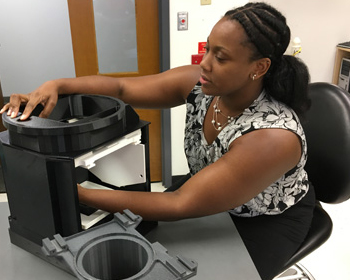The Near Infrared Airglow Camera (NIRAC) is a 45-kilogram device that hitched a ride to the International Space Station (ISS) on May 3, 2019 as part of the Department of Defense Space Test Program. NIRAC has two mission objectives: to study lower atmospheric processes that affect space weather, and to exploit airglow for nighttime imagery applications.
Capturing Airglow Imagery

Airglow is a natural atmospheric emission related to aurora – in both cases, light is emitted from an excited atom or molecule, although the cause of excitation is different. Airglow is dimmer than aurora and occurs over the entire Earth, not just the poles.
Visible airglow is rather weak, but NIRAC will study the infrared portion of the spectrum, which is much brighter. Using this illumination, the camera will be able to capture images of the ground and clouds at night when there is no other light.
“We’re interested in using the airglow layer as a flashlight to look at the ground,” Dr. Lynette Gelinas said. “In this band, it’s pretty bright; it’s almost as if you’re looking at the ground under a full moon.”
NIRAC Camera Captures Atmospheric Glow
Space Weather
NIRAC will also contribute to the study of space weather. Weather on Earth, a more familiar concept to most, focuses on conditions in the lower atmosphere.
“Space weather describes conditions in the upper atmosphere and in the near-Earth space environment that can affect spacecraft, for example, ionospheric disturbances that degrade communications signals from satellites,” Gelinas said.
Airglow, which occurs at about 85 kilometers altitude, is conveniently located between the lower atmosphere and space weather and can be used to gain information about interactions between the two.
“Airglow is a chemical reaction which means that density and temperature perturbations will change the amount of light emitted, helping us study the characteristics of the upper atmosphere,” said Gelinas.
Aerospace has previously used ground-based airglow cameras to study this, but they provide a limited field of view. NIRAC is taking this capability to space.
NIRAC Camera Challenges

To prepare the airglow camera for the ISS, the team had to downsize the imaging mechanism, make it space compatible, and keep everything from overheating. Not only was this accomplished, but the technology they developed could also be used for other applications.
“The resulting space-qualified detector-cooler assembly will allow use of highly capable focal plane arrays on small platforms, including small satellites, hosted payloads, multiple-unit CubeSats, and unmanned aerial vehicles,” Gelinas said.
The NIRAC’s location atop the ISS presents another challenge, in that it gives the camera a distorted field of view, making it difficult to compensate for the movement of the ISS and Earth during image exposure. Undaunted, the team developed a custom lens that solves the problem. Having overcome these technical challenges, the team is looking forward to the data NIRAC will collect.
“We’ll be viewing airglow perturbations as never seen before – both in sensitivity and scale size, which will require development of more sophisticated data analysis techniques,” Gelinas said. “We also expect that NIRAC observations will lead to new science investigations studying the coupling of the lower atmosphere to space.”
Editor's note: This story was originally published on Nov. 1, 2017. It is being republished to coincide with NIRAC's May 3 launch.
This technology is available for license.
Technology Transfer at Aerospace
Aerospace has a variety of technologies available for licensing. For commercial companies, Aerospace may offer royalty-bearing exclusive or nonexclusive licenses, options, and low-fee evaluation licenses. For not-for-profits, FFRDCs, universities, and government agencies, Aerospace may offer royalty-free licenses.
Our office can assist you with executing a Non-Disclosure Agreement (NDA), software releases and end-user licenses, as well as patent know-how and copyright licensing.
Contact us at ip@aero.org.








